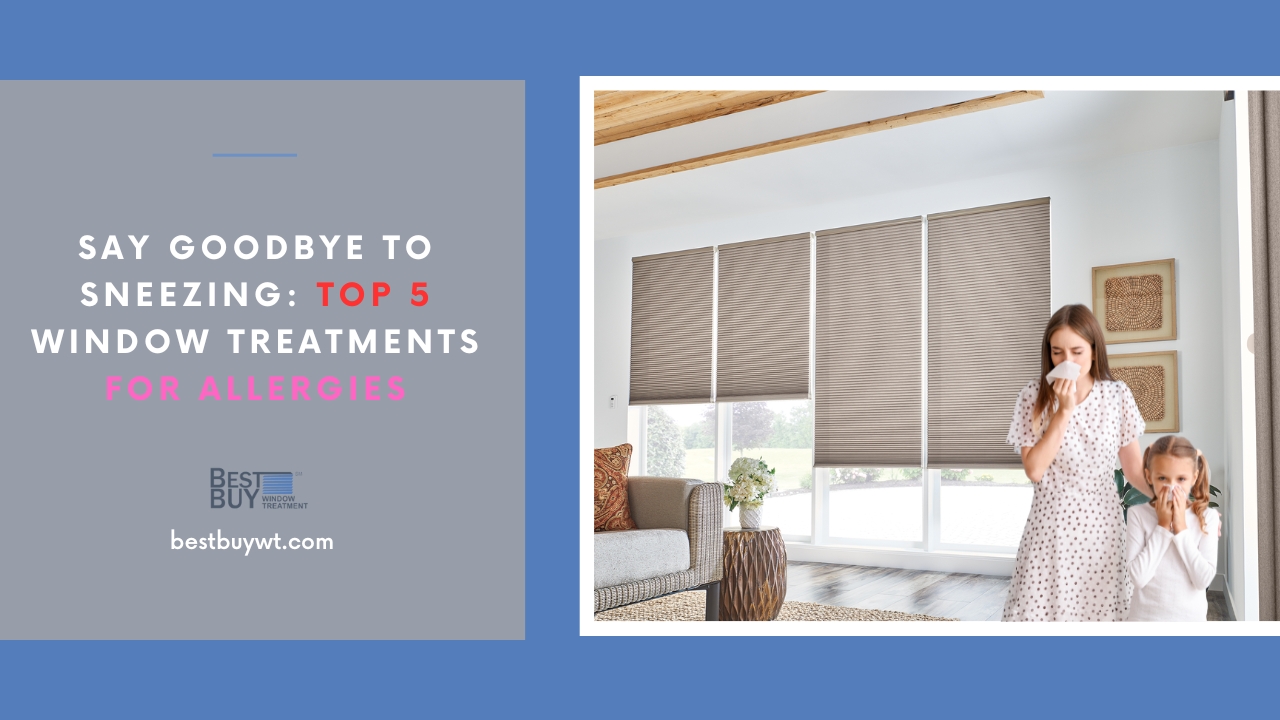Do you suffer from allergies? Sneezing, itchy eyes, and a runny nose can be a real pain – especially during allergy season. But did you know that the right window treatments can actually help reduce your symptoms?
One way to reduce allergy symptoms is by investing in proper window treatments. Windows are one of the main entry points for allergens such as pollen and dust into your home. By choosing the right type of window treatment, you can minimize these allergens from entering your space and making you sneeze like crazy!
Allergies are caused by an immune system overreaction to substances like pollen, dust mites, and pet dander. When these allergens enter your body, they trigger inflammation and other unpleasant symptoms. And while there’s no cure for allergies, there are ways to manage them – including through the use of window treatments.
In this article, we’ll explore the top 5 window treatments for allergies and explain how they can help you say goodbye to sneezing once and for all!
Common Allergens that Come through Windows
1. Pollen: During the spring and summer months, pollen is one of the most common allergens that come through windows. It is produced by plants, and when it enters your home, it can cause sneezing, itching, and watery eyes in sensitive individuals.
2. Dust mites: These tiny creatures are commonly found in bedding, carpets, and upholstery; however, they can also enter your home through open windows. Dust mite allergies can cause symptoms such as coughing, wheezing, and chest tightness.
3. Mold spores: Mold thrives in warm and humid environments such as bathrooms or kitchens; however, they can also enter your home through open windows during damp weather conditions. Mold spores can cause allergic reactions ranging from mild to severe symptoms such as asthma attacks or skin rashes.
4. Pet hair/fur: Pet hair fur can be a major contributor to allergies, especially for those who are particularly sensitive. Pet dander, which is found in pet hair and skin, can cause sneezing, coughing, and other allergy symptoms. One way to combat this issue is by regularly grooming your pets to reduce the amount of hair they shed.
Top 5 Window Treatments for Allergies
1. Blackout Curtains
Blackout curtains are not just for creating a dark ambiance in your bedroom, they can also be used to reduce allergies. These curtains have an additional layer of fabric that is used to block out sunlight, which also helps to prevent the entry of dust and other allergens. The thick material reduces the amount of outdoor pollution coming into your home as well. You can enjoy a peaceful sleep without any sneezing or allergy-related symptoms.
These curtains work by creating an extra layer between your space and the outdoor environment, ensuring maximum protection against allergens. With their heavy fabric construction, blackout curtains can efficiently trap allergens before they have a chance to enter your space.
Blackout curtains also provide insulation against outdoor noise and temperature changes. They can help you sleep better by creating a dark, quiet, and comfortable environment in your bedroom. You can choose from a variety of styles and colors to match your decor and personal preferences.
Furthermore, these curtains are versatile and can be used alone or with another layer of fabric depending on the severity of your allergy symptoms. Say goodbye to sneezing with blackout curtains – the perfect solution for people looking to eliminate allergens from their living spaces!
2. Cellular Shades
Cellular shades are a great option for those who suffer from allergies. These shades have a unique design that creates small pockets of air which helps to insulate the window and keep allergens out. Unlike traditional blinds or shades, they don’t have unsealed gaps, which significantly reduces dust accumulation in homes and thus reduces the amount of allergens present in the air in your home. The fabric used in cellular shades is also often treated to resist mold and mildew growth, making them even more allergy-friendly.
Another benefit of cellular shades is that they come in a variety of colors and fabrics, so you can choose one that matches your decor while still keeping your allergies at bay. They also offer excellent privacy control and light filtering options, allowing you to adjust the amount of natural light entering your home without sacrificing privacy.
Additionally, Cellular shades have an assortment of colors as well as upgrade options like Cordless operation which would add some child-safety aspects while being easy-to-use. Therefore with these benefits, cellular shades could be an excellent choice for anyone whether you are someone who suffers from allergies or simply looking to enjoy a more comfortable and healthy indoor living space.
3. Roller Shades
Roller shades are one of the most popular window treatments available on the market today. One of the key benefits of roller shades is their ability to block both light and pollen while still preserving visibility. This means that you can enjoy natural light without exposing yourself to allergens in the process.
Roller shades are also easy to install and maintain, making them a practical solution for allergy sufferers. Roller shades are a great option for those who want a simple and durable window treatment.
Additionally, the material is built to last, offering long-lasting durability. These shades come in a variety of colors and styles, making them a great addition to any room in your home. If you suffer from allergies or have a sensitivity to light, roller shades may be just what you need to help keep your symptoms at bay.
Not only do they offer protection against allergens and bright sunlight, but they also add a touch of style and elegance to any space. Whether you prefer bold patterns or soft hues, there’s sure to be a roller shade that can meet your needs.
With their durability, ease of use, and versatile design options, they offer a great combination of style and functionality that can provide lasting relief from sneezing and other bothersome symptoms caused by allergies.
4. Vertical Blinds
Vertical blinds are a great option for those who suffer from allergies. Vertical blinds have become a popular choice for those looking to combat pesky allergens in their home. One of the key features and benefits of vertical blinds is that they’re suitable for larger windows, sliding doors, and offer versatile control options. These types of window treatments help prevent dust buildup and are easy to clean.
They can be wiped down with a damp cloth or vacuumed with an upholstery attachment to remove any dust or allergens that may have settled on them. Vertical blinds also offer versatility in terms of light control, allowing you to adjust the amount of natural light coming into your home.
Finally, vertical blinds come in a variety of materials including vinyl, fabric, and wood which means that there is an option for every style preference and budget. Whether you want a sleek modern look or a classic traditional feel, there is sure to be a set of vertical blinds that will suit your needs.
5. Plantation Shutters
Plantation shutters are a great choice for those prone to allergies. These versatile window treatments are not only aesthetically pleasing but also offer a wide range of benefits that can help minimize the impact of allergens in your home.
One of the most significant advantages of plantation shutters is their classic look, which adds elegance and sophistication to any room. They also provide excellent light control, allowing you to adjust the amount of natural light entering your home. This feature is particularly useful for individuals with allergies since too much sunlight can cause allergic reactions such as sneezing or watery eyes.
Furthermore, plantation shutters offer superior privacy control compared to other types of window treatments. The adjustable louvers allow you to customize the amount of privacy you need while still letting in natural light and fresh air.
The Bottom Line
In conclusion, choosing the right window treatment can significantly reduce allergy symptoms and improve overall health. Among the top 5 options, cellular shades and roller shades stand out as the most effective in blocking allergens from entering indoor spaces. These treatments not only filter out pollen, dust mites, and other irritants but also provide insulation against temperature changes.
It’s important to consider factors such as material type, UV protection, and ease of maintenance when selecting a treatment that suits your needs.
Additionally, it’s worth noting that combining different treatments can provide even more protection against allergens. For example, pairing cellular shades with curtains or drapes can create an extra barrier against pollen and other irritants.
Overall, taking steps to mitigate allergies through window treatments is an easy way to enhance indoor air quality and promote well-being. With a range of stylish options available on the market today, it’s easier than ever to create a comfortable living space free from sneezing fits and other symptoms associated with allergies.

